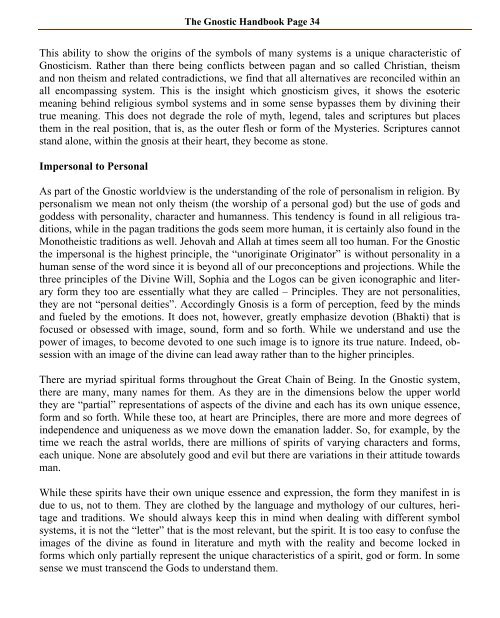gnostic handbook
gnostic handbook
gnostic handbook
Create successful ePaper yourself
Turn your PDF publications into a flip-book with our unique Google optimized e-Paper software.
The Gnostic Handbook Page 34<br />
This ability to show the origins of the symbols of many systems is a unique characteristic of<br />
Gnosticism. Rather than there being conflicts between pagan and so called Christian, theism<br />
and non theism and related contradictions, we find that all alternatives are reconciled within an<br />
all encompassing system. This is the insight which <strong>gnostic</strong>ism gives, it shows the esoteric<br />
meaning behind religious symbol systems and in some sense bypasses them by divining their<br />
true meaning. This does not degrade the role of myth, legend, tales and scriptures but places<br />
them in the real position, that is, as the outer flesh or form of the Mysteries. Scriptures cannot<br />
stand alone, within the gnosis at their heart, they become as stone.<br />
Impersonal to Personal<br />
As part of the Gnostic worldview is the understanding of the role of personalism in religion. By<br />
personalism we mean not only theism (the worship of a personal god) but the use of gods and<br />
goddess with personality, character and humanness. This tendency is found in all religious traditions,<br />
while in the pagan traditions the gods seem more human, it is certainly also found in the<br />
Monotheistic traditions as well. Jehovah and Allah at times seem all too human. For the Gnostic<br />
the impersonal is the highest principle, the “unoriginate Originator” is without personality in a<br />
human sense of the word since it is beyond all of our preconceptions and projections. While the<br />
three principles of the Divine Will, Sophia and the Logos can be given iconographic and literary<br />
form they too are essentially what they are called – Principles. They are not personalities,<br />
they are not “personal deities”. Accordingly Gnosis is a form of perception, feed by the minds<br />
and fueled by the emotions. It does not, however, greatly emphasize devotion (Bhakti) that is<br />
focused or obsessed with image, sound, form and so forth. While we understand and use the<br />
power of images, to become devoted to one such image is to ignore its true nature. Indeed, obsession<br />
with an image of the divine can lead away rather than to the higher principles.<br />
There are myriad spiritual forms throughout the Great Chain of Being. In the Gnostic system,<br />
there are many, many names for them. As they are in the dimensions below the upper world<br />
they are “partial” representations of aspects of the divine and each has its own unique essence,<br />
form and so forth. While these too, at heart are Principles, there are more and more degrees of<br />
independence and uniqueness as we move down the emanation ladder. So, for example, by the<br />
time we reach the astral worlds, there are millions of spirits of varying characters and forms,<br />
each unique. None are absolutely good and evil but there are variations in their attitude towards<br />
man.<br />
While these spirits have their own unique essence and expression, the form they manifest in is<br />
due to us, not to them. They are clothed by the language and mythology of our cultures, heritage<br />
and traditions. We should always keep this in mind when dealing with different symbol<br />
systems, it is not the “letter” that is the most relevant, but the spirit. It is too easy to confuse the<br />
images of the divine as found in literature and myth with the reality and become locked in<br />
forms which only partially represent the unique characteristics of a spirit, god or form. In some<br />
sense we must transcend the Gods to understand them.


